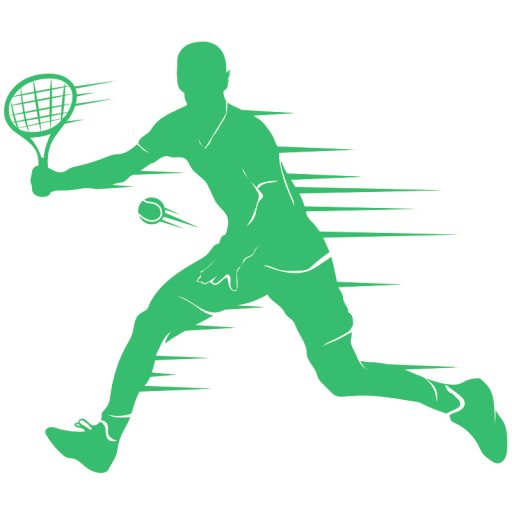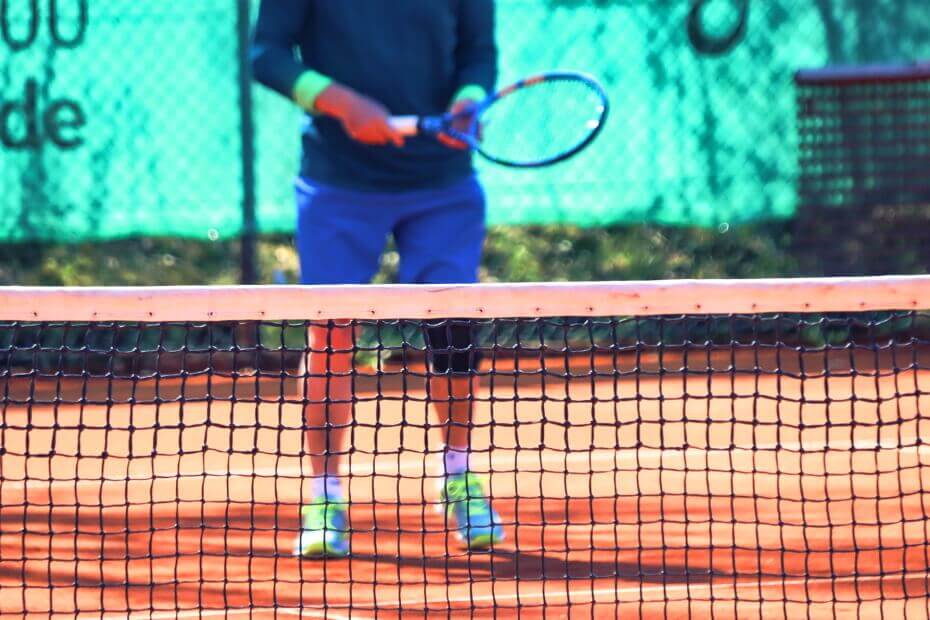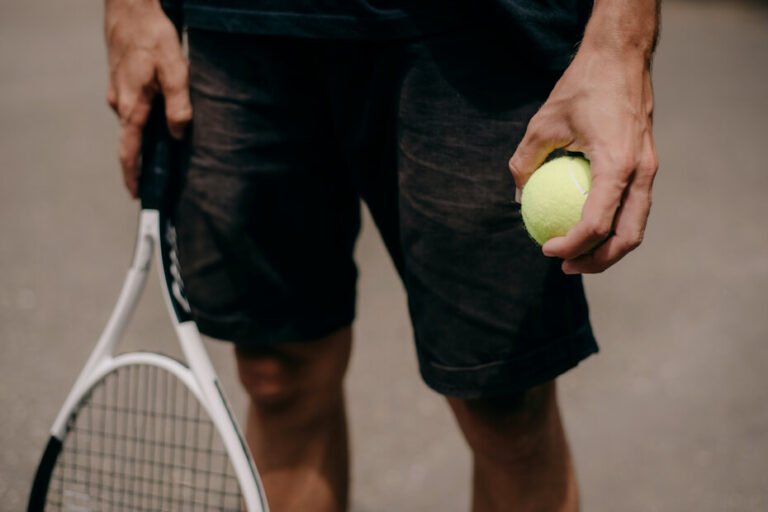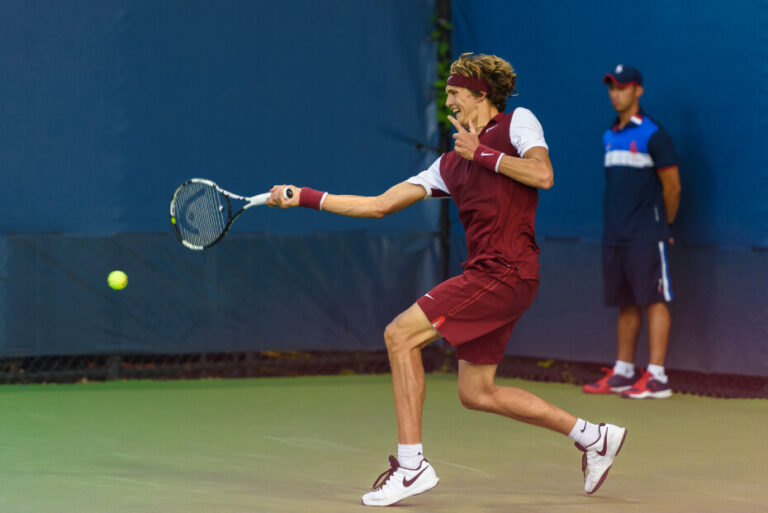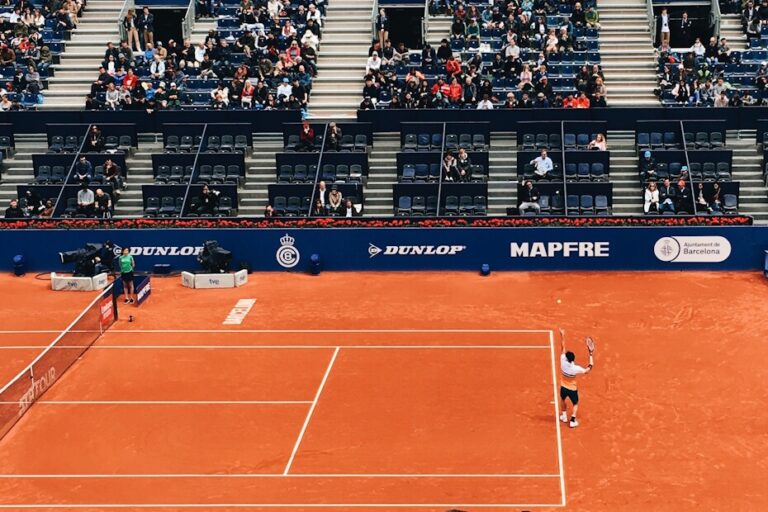With the day’s growing longer, the air turning warmer, and the sun shining brighter than ever, this can only mean one thing – Summer’s here!
Summer is the favorite season for a lot of people, and we can understand why that is. Summer is a particularly enjoyable season for sports fans and for many, there is one sports tournament that is synonymous with the summer, and that is Wimbledon.
In July of each year, tennis fans get to sit down and enjoy the world’s greatest players battle it out for one of tennis’ prestigious titles. While watching tennis is a whole lot of fun, you can’t beat the excitement of emulating your favorite stars at Wimbledon, by getting involved in a game of tennis.
Playing tennis is a great way to have fun, flex your competitive muscles, work on your fitness, and improve your coordination. The problem is that tennis is also a very difficult sport to learn. With all kinds of rules to memorize and shots such as the volley to master, it’s easy to see why people struggle.
If you want to bring up your game, you’re going to have to learn how to volley in tennis, which is what we’re going to be helping you with today.
What is a Volley in Tennis?
Don’t worry, we know you’re eager to hit the tennis courts and start smashing some volleys so we won’t keep you for too long.
Before we can help you to hit a tennis volley so perfect that Roger Federer himself would be jealous of, we need to make sure you’re familiar with what exactly a tennis volley actually is.
A tennis volley is a very unique shot or stroke in tennis, whereby the player returns the ball to their opponent before it has the chance to bounce on the ground. Volleys are difficult to deal with as they are usually performed either close to the net, or close to the service line.
Unlike in football/soccer, a volley isn’t designed to be hit with power, although if you catch the ball right, you can certainly put a lot of power onto it. The primary function of a volley is to make your opponent run and to catch them out of position by making them race to hit the ball in time.
Volleys can also be useful for buying you some time and for interrupting the tempo of the tennis rally.
For forehand volleys, players will usually use their dominant arm and hand, although backhand volleys require the use of the non-dominant arm and hand, making a backhanded volley a much tougher shot. You nail a backhand volley, though, and your opponent is going to be in big trouble.
As far as grip goes, although sometimes preference enters the mix, most tennis players will use a continental grip on their racquets. More capable and advanced players, though, will use an Eastern forehand grip instead.
Types of Volleys
When people talk about tennis volleys, it’s important to remember that there are multiple types of volleys for tennis players to choose from. Although similar, there are key differences that set each volley apart from the last.
If you want to volley like the Williams sisters, you’re going to have to learn the six different types of volleys we’ve got listed down for you below.
1. Drop Volley
Up first, we have the drop volley.
A drop volley is a tennis shot that requires precision accuracy and a light touch as it is played lower than some of the other volleys you’re about to read about.
With a drop volley, the aim is to basically play the ball with a volley so that it lands softly on the opposing side of the net, as close to the net as possible. This is simply so that your opponent has to run further to reach the ball.
Not only that, but as the ball lands so close to the net, it makes it much harder for your opponent to hit the ball over the net onto your side of the court.
Obviously, the idea here is for the ball to just clear the net and bounce twice before your opponent reaches it, although as mentioned if it bounces once and your opponent hits it but doesn’t manage to clear the net, you win the point so it’s all good.
If you think of a drop volley like a drop shot played at the net, that’s pretty much what it is.
2. Punch Volley
Although it sounds aggressive, a punch volley isn’t actually anywhere near as aggressive as it sounds.
A punch volley is basically a standard volley used for net play. To perform a punch volley, the player located at the net will punch their racquet down slightly and forward to generate underspin on the ball.
These shots are all about accuracy and technique rather than power, so obviously there is no backswing required.
When playing this shot, you want the ball to have comfortably cleared the net while traveling at a moderate pace.
3. Lob Volley
A lob volley may be called for if both you and your opponent are approaching the net simultaneously, and it would be tricky for you to perform a passing shot.
In a lot of amateur tennis matches, you’ll find that this scenario results in players engaging in a rally of volleys. You don’t want to do this, though, you want to put it to bed early and bag yourself a point, so you’ll want to play a lob volley shot instead.
When you execute a lob volley, you’ll open up the face of your racquet to hit the ball in a high arc up and over your opponent’s head so that it passes them and bounces in play before the baseline.
4. Block Volley
If you thought that a punch volley required no power, just wait until you execute your first block volley.
A block volley requires virtually no movement or power at all. As the name implies, with a block volley you literally hold up your racquet and use it to block your opponent’s shot in such a way that it clears the net and bounces in their half of the court.
5. Half Volley
A half volley is arguably the toughest volley to perform, as the goal here is to hit the ball when it bounces, connecting with it just as it has hit the ground and started its ascension.
Some players call this the ‘on the rise shot’ and as you might expect, timing really is everything here as you need to hit the ball on the bounce, rather than just before.
6. Swinging Volley
Finally, for the last of our six volleys, we have the swinging volley.
This is the bad boy of the tennis world, the John McEnroe if you will, in the sense that it goes against everything you’d expect a volley to stand for.
A Swinging volley breaks all of the rules of a regular volley as it is performed when a player utilizes a groundstroke swing technique to hit the ball out of the air before it has bounced.
While a swinging volley is often a shot used out of pure desperation when players find themselves caught between the baseline and the service line (also known as No Man’s Land), if performed correctly, it is incredibly difficult to deal with.
Because the technique required is so precise, swinging volleys are best performed by advanced tennis players. This is because the shot requires the perfect balance of power, swing, and pace to ensure that the ball remains in play.
If you really want to impress your fellow tennis pros, however, you’ll take a little extra time when learning this shot.
The Keys to the Perfect Volley Technique
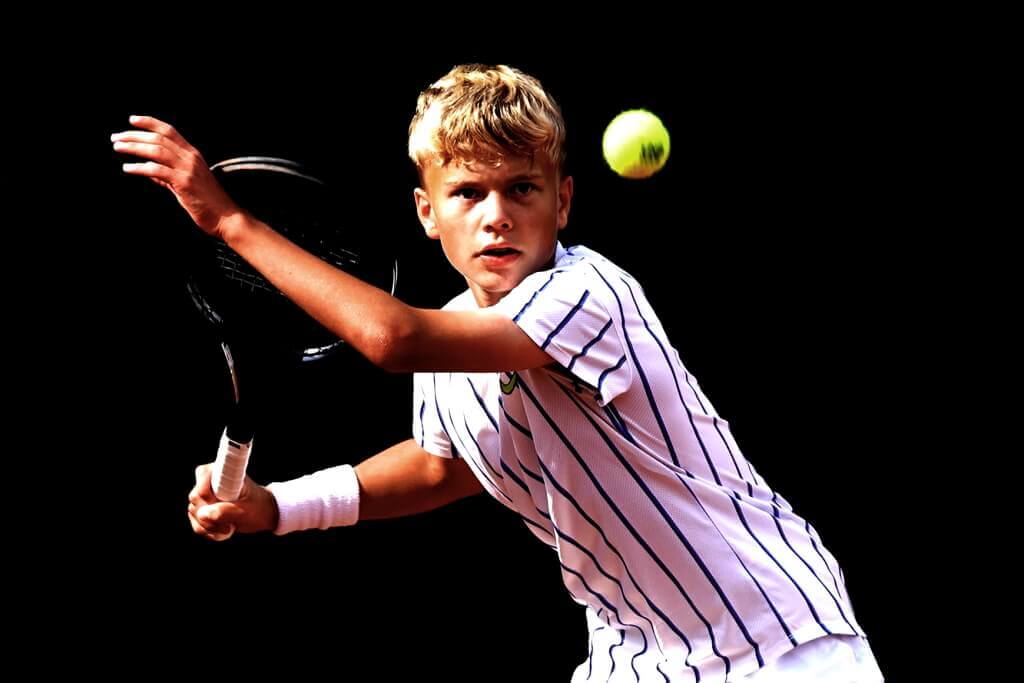
Okay, so we’ve looked at what volleys are, and you now know the different variations, so now comes the tricky part – mastering the volley.
Performing the perfect tennis volley is not easy, but it can be done, and to prove it we’re going to share some tips with you to help ensure you’re the one that’s hitting them as they should be hit.
Here’s a look at some of the key fundamentals for the perfect tennis volley technique.
1. Make Sure You’re in the Right Position
When it comes to volleys, position is everything, which means that you must ensure that your footwork is on point to make sure you can get into position quickly.
If you’re a beginner in tennis, you might want to use what is known as a split step as this will help you to get into a more comfortable position where you have more control before you get ready to hit the volley. A split step is basically a straightforward jump in the air where you land on a balanced point with your legs out.
You of course need to ensure that you know what kind of volley you’re hitting, but once you know whether you’re hitting a backhand volley or a forehand, you should rotate your body and twist 45-degree from the net, making sure your hips are slightly closed. You should also pay attention to your feet, which should also be staggered at roughly the same 45-degree angle as your torso.
If you are right-handed your left foot will be in front of you whereas left-handed players will want their right foot forwards for forehand volleys. For backhand volleys, right-handed players will want their right foot forwards and left-handed players will want their left foot forwards.
2. Select the Right Grip
The grip is so, so important when it comes to tennis and performing the different tennis shots out there. Arguably the most important tennis shot when it comes to grip, however, is the volley.
Of course, different people have different needs and requirements, but generally speaking, you will find that a volley is best performed using a continental grip. The reason for this is that a continental grip allows for volleys to be hit with a backhand and with the forehand, without having to adjust your hand position.
When performing a volley, time is not on your side so make every second count. The last thing you want to be doing is having to alter your hand position to hit a shot as, by the time you’ve switched things around, you’ll likely have already conceded the point. With a continental grip for most volleys, however, you won’t need to worry about changing hands.
3. Nail That Motion
To execute the volley to rule all volleys, you need to really get your racquet motion on point, which is what we’re going to be addressing next.
If you wish to perform a standard volley, you will need to go ahead and go with a racquet face that is open ever-so-slightly, before making a downward cut in your volley motion. This will generate the backspin needed to make the ball bounce into your opponent’s half of the court. If executed correctly, the ball should bounce low and awkwardly, making it a real nightmare for your opponent to deal with.
Keep your head down, and your eye on the ball at all times, making sure to move your hand in the direction that you want the ball to travel.
4. Ensure Your Racquet is in the Correct Position
As well as addressing grip, stance, and motion, another key factor when it comes to hitting the perfect volley is the racquet position.
One of the biggest mistakes that tennis players make when trying to hit a volley during a match, is having their racquets either too far back, or too high for their attempts at a volley.
If you want to hit a clean volley you need to make sure that your racquet is located behind the location where it will make contact with the ball, without bringing it down and behind your body.
A common mistake that beginners make when trying to execute a volley, is to bring the racquet back too high, which means that they then have to chop downwards onto the ball, causing it to float and pop up. If you bring the racquet back too far behind you, you run the risk of making a mistake and connecting poorly with the ball. It also makes hitting the volley that little bit tougher.
Depending on how low the volley is, you’ll want a firm grip, with your hand just under the head of the racquet with the strings tilted up a little. The lower the volley is, the higher your strings will need to be pointing to get the ball up and over the net.
Because you are already positioned close to the net there’s no need to swing like you would with a groundstroke. Unless you’re hitting a half volley you are also striking the ball before it bounces so the momentum of the ball itself is what is used to generate power.
As far as your grip goes, for more powerful shots you will want a firm grip. For weaker shots such as a drop shot, however, you can relax your grip slightly as your wrist will absorb more of the impact.
5. Stand Closer to the Net
The more attentive readers amongst you will now be well aware of the fact that most volleys are performed close to the net. Needless to say, if you wish to execute the sweetest of volleys, you will likely need to be standing closer to the net.
The closer you are positioned to the net, the easier your volley will be. You’ll find that it is much easier to clear the net and have it land on your opponent’s side of the court if you’re positioned closer to the net, to begin with.
Now, we aren’t saying you should spend all of your match standing by the net on the off-chance that you do get to execute a volley, but we are saying that if you do anticipate a volley shot is required, you’ll need to get your butt close to that net pretty darn sharpish.
A common mistake that tennis newbies tend to make is allowing the ball to bounce or drop below their waists before they hit it, making it much harder to execute correctly. Rather than this, you should instead move forwards and try to nail the volley at the highest point you can. When you think about it, it makes perfect sense. After all, would you rather stoop down to hit a volley at your knees, or hit it at shoulder height?
A very simple tip here is to try to be positioned roughly halfway between the net and the service line for your volleys. Volleys should generally never be hit from the service line unless, of course, you are hitting a half volley so as to move closer towards the net.
6. Keep Moving Forward
In tennis, just as in life, you should always try to keep moving forward, when you’re hitting a volley.
Hitting a volley when you’re moving backward or sideways is incredibly difficult so try to make sure you’re always moving forward. Your feet and your body weight should both be leaning forward and moving forward into the volley that you’re playing.
Just as you strike the ball, try to transition your weight from your rear foot to your front foot. You should also open up your hips from a closed position to enable your arms to release the energy from the racquet into the ball.
7. Practice With a Partner
As useful as this guide hopefully is for you, the simple truth of the matter is that in order to really perfect your volleys and your tennis abilities in general, you’re going to have to practice. After all, practice makes perfect.
A very simple, yet extremely effective drill you can carry out when practicing your volley technique is to have somebody throw a tennis ball directly into your racquet while you hold it in place gently in the position of your volley of choice.
Have them throw the ball at a pace that will mimic that of a tennis shot. When they throw the ball, make sure you don’t move your arm, instead, allow the ball to slightly push your racquet backward.
As you progress, move your arm forward slightly, while still allowing the ball to push your racquet back gently. Your goal here should be to hit the ball gently and ensure you can feel it push your racquet head back gently upon contact with the tennis ball.
Once you’ve gone through these drills several times you’ll find that the feeling and the technique needed to perform a volley come more naturally to you. As you progress further, you can work on topspin, backspin, slicing, and underspin, which will all eventually help you to enjoy more control of the volley.
8. Practice With a Tennis Backboard
If the above drill isn’t possible due to you not having a tennis partner available, no problem, just go ahead and improvise slightly.
Simply go ahead and use a tennis backboard, also known as a tennis wall, or even a regular brick wall if you can, and hit some shots against it, practicing your volley form and technique on the return shots.
Try for multiple backhand volleys and forehand volleys, moving on to some of the other variants we mentioned previously. Again, practice makes perfect, and the more volleys you hit during practice, the better they’ll be when you hit the courts.
